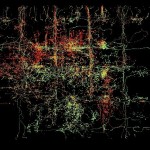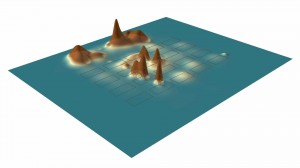We are a tool-using animal. We make tools to extend our bodies, such as a rake for reaching, but also tools to extend our minds, such as notations for performing calculations. Tools solve old problems, but they also enable us to frame new problems. When we talk through a problem — in the laboratory, say, or at the kitchen table — we use linguistic tools (language) to think about our problem, or about our lives. But this exercise of our tool-using know-how also enhances and develops our mastery. To use a tool effectively requires know-how, and it affords deeper understanding.
Scientists — who seek knowledge — frequently make models of phenomena in the domain that interest them. Working with the model, thinking about the model, enables them to think about what is modeled. The weather bureau models a storm system in the hopes of predicting the storm’s behavior. Models are a very sophisticated kind of tool.
Synchronous Objects is model of One Flat Thing, reproduced. It is an instrument for thinking about this choreographic structure. one flat thing, revisited is work of art, to be sure, but it presents itself to its audience as a complex phenomenon, that is to say, as an event; the work is compelling and absorbing, but it is also, like many dances, and like life itself and the environments we occupy, very difficult to understand; that is, it is nearly impossible to command a clear view of it. Synchronous Objects, then, is an instrument designed to model the dance — along several distinct dimensions of its complexity (e.g. cuing relationships, counterpoint, kinds of actions). If it is effective, it will help the audience (and also the dancers and the choreographer) command a clear surview of the complex whole.
For one thing to model another, it must, at least notionally, exhibit something like the complexity, or the possibilities, of that which it models. A map, for example, must stand in a pointwise relation to the city it describes. This means it is always possible to get lost in our maps, or in our models. But it also means that our models become objects of inquiry in their own right. This is a common transformation in the history of thought. We devise a formal system in mathematics, for example, in order to see what follows from our theorems; we then make the system itself and the question of its soundness, completeness, consistency, etc, our object of investigation. If Synchronous Objects objects is successful, then it is likely to command our interest and attention in its own right. And because no tool or rule is self-explanatory, it will raise problems about how we are to understand it. And so the process of learning, questioning and learning more, moves forward. When it comes to understanding, there is no equivalent to the atomic bomb. So Synchronous Objects objects, this instrument, really, is a gesture towards a conversation that will, that must, go on. It will go on differently than it would have.
Forsythe’s work, if I understand it, very frequently takes these questions about knowledge, investigation, modeling as its very own concerns. one flat thing, revisited itself in a way models, or plays with the idea of modeling, Scott’s failed journey to the North Pole, and so the effort to model the dance itself is a way of engaging directly with the dance. But there is more. We are, after all, a tool-using animal and what art enables us to do — alone with philosophy perhaps — is to try to frame a clear surview of our lives, of our work to bring the world itself into focus for ourselves, and, in particular, of the role of tools (pictures, gestures, stories, models) in our lives. If this is right, the work of one flat thing, revisited, and the work of Synchronous Objects are one.
—Alva Noe



 NORAH: Ola, let’s start with a discussion of your involvement in the project. I’ve had a long term interest in geography because of my previous work in environmental science but for many people the connection between dance and geography might seem surprising.
NORAH: Ola, let’s start with a discussion of your involvement in the project. I’ve had a long term interest in geography because of my previous work in environmental science but for many people the connection between dance and geography might seem surprising.
Recent Comments